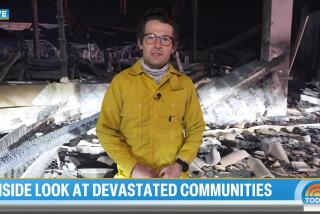AMATEURS CAPTURE NEWS WITH VIDEO CAMERAS
- Share via
“Eyewitness news” is starting to really be eyewitness news as the number of amateur video enthusiasts grows.
According to the latest estimates, 39% of American homes with television sets also have videocassette recorders. In the wake of the VCR success, a video-camera boom is developing, particularly with the advent earlier this year of VHS and 8mm models that weigh less than five pounds. With prices expected to fall, those video “camcorders” should become even more popular.
And as they proliferate, cameras bought to tape vacations and record the kids’ growth are also playing unexpected roles. One of those roles was demonstrated last Sunday in the TV coverage of the Cerritos air disaster.
Some local stations and networks supplemented their footage of the tragedy with shots taken by at least two non-professionals. One of the amateurs was a Cerritos resident, Dean Gross, who took dramatic shots of the inferno just minutes after the crash. According to Tom Capra, news director at KNBC-TV, Channel 4, the tape was purchased by that station (and for the NBC network) for $500.
Scott Weimer of Buena Park also provided tape of the disaster’s aftermath to KNBC and to KTTV Channel 11, though he arrived at the scene “just as the firemen were knocking it down,” he told The Times. “They did an excellent job.”
Weimer should know. He’s a fireman himself for the Buena Park department. Coincidentally, he also was at the similar San Diego air disaster eight years ago; he was with the Fallbrook department then and his company was one of the many called on to help out. This time, though, he was off-duty and driving on the freeway when he spotted the rising black smoke from the Aeromexico crash.
“I do a little video work in my spare time for small Orange County businesses,” said Weimer, “and I had one of my two cameras in the car with me--a Panasonic VHS model.” The news media still hadn’t arrived when Weimer shot his tape. He made several copies at home and passed them on to the stations without charge (though he says KTTV has indicated it will pay him $100). He believes other stations also used some of his tape, though he is not sure how they got it.
On a somewhat less somber note, on Monday the Cable News Network, the syndicated British Independent Television News and other TV news services showed some startling tape shot by a free-lancer at the zoo on Jersey in the Channel Islands.
According to a CNN spokeswoman, a 5-year-old boy named Levan Merritt had been placed on top of the railing of the gorilla pit to get a better view and fell in. The big male gorilla Yambo examined the unconscious boy and stroked his head in puzzlement. Then the boy woke, looked up and shrieked--sending the gorillas scurrying away in fright. Zookeepers then entered the area and removed the boy, who suffered a broken arm and head injuries from the fall.
All of those sights and sounds, except for the actual fall, were caught by someone who just happened to bring a consumer-style video camera to the zoo that day--and took the footage to the local station, Channel TV, which then passed it on to other news services. “The quality of the tape was very good,” the CNN spokeswoman said. “We believe that it was a Sony Beta camera.”
Fireman/cameraman Weimer (who does not, he noted, use his video equipment at the department) also pointed out that non-professional videotaping might eventually save lives. “If someone just happened to catch on video the beginning of a fire, or the actual collision of two planes, it could be a big help in analyzing what went wrong.”
At KNBC-TV, Capra said that we should expect to see more eyewitness footage as the video revolution progresses. Of course, there’s nothing new about the media using amateur material; still photos and film have been bought from non-staffers for decades. But video is special, Capra noted: “It’s accessible right away. When people bring in film, it has to be processed before we can see it. With videotape, we can look at it immediately and determine whether we want to use it. Here at KNBC we have machines for every type of format, and the ability to transfer whatever’s brought in to three-quarter (industrial-format) tape.”
And when Capra, the son of renowned movie director Frank Capra, goes on vacation, what kind of camera does he prefer to use--video or film? “Neither,” he laughed. “I just shoot stills.”
More to Read
Sign up for Essential California
The most important California stories and recommendations in your inbox every morning.
You may occasionally receive promotional content from the Los Angeles Times.













